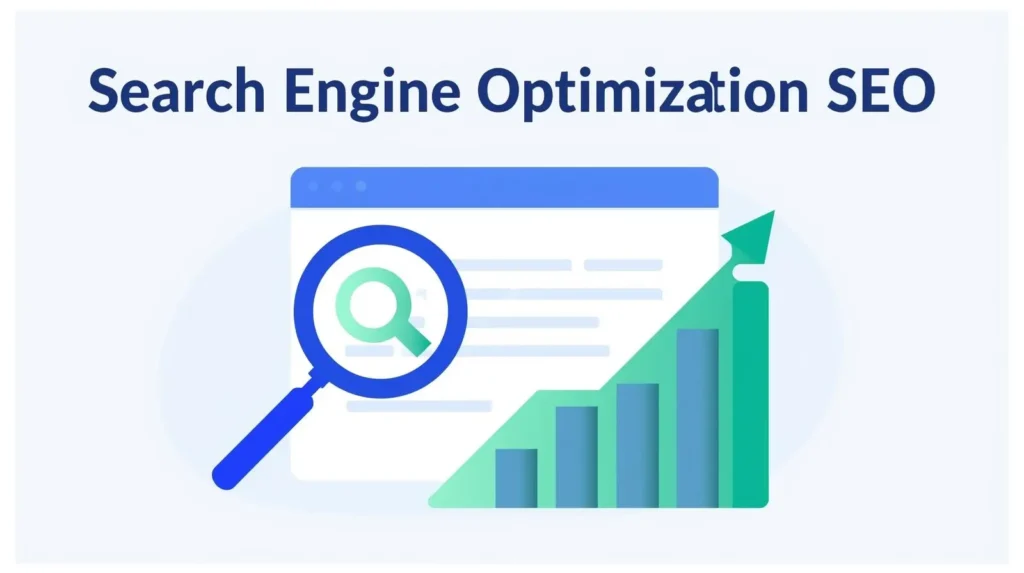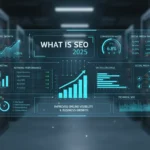What if you could reach the exact people you want, at the exact moment they’re ready to act? That’s the promise behind the question “what is digital marketing” and here’s the curiosity‑spark: most teams use only a fraction of the levers available to them. In 2025, the businesses that grow fastest aren’t louder; they’re clearer. They know which channels fit their buyers, how to turn clicks into customers, and how to prove return without guesswork.
This comprehensive guide unpacks what is digital marketing in plain language. You’ll get the core definition, the channels that matter (and when), a step‑by‑step strategy framework, conversion and content playbooks, measurement and attribution explained, budgeting models, compliance essentials, and the KPIs that actually move profit. No fluff just the systems and examples you can apply immediately.
For more practical growth explainers, bookmark ghodkes.com.
Table of Contents
What Is Digital Marketing?

What is digital marketing? It’s the strategy and set of channels you use to reach your target audience online, earn their attention with useful content and clear offers, and convert that attention into sales and long‑term customer relationships. Done well, it’s not a series of campaigns it’s a system: know who you’re for, be helpful where they are, measure what matters, and keep only what pays.
Key elements:
- Owned channels you control (website, email/SMS, content)
- Earned channels you influence (search visibility, social shares, reviews, PR)
- Paid channels you rent (search ads, social ads, display/video)
- Measurement layer that tells you what’s working (analytics, attribution, KPIs)
Digital marketing is simply how you connect the right people with the right message at the right time and prove that it created value.
Why 2025 Changes How to Plan and Measure
- Attention is fragmented: Users bounce between search, short‑form video, communities, and marketplaces. You need channel‑native creative and a consistent narrative.
- Privacy rules matter more: Consent, first‑party data, and server‑side tracking are the new normal. Clean tagging beats clever tricks.
- Zero‑click behavior: People find answers directly in search results and social profiles. Helpful snippets and complete profiles are now part of conversion.
- Creative is performance: Algorithms optimize to satisfaction. Clear hooks and benefits beat generic copy.
- Proof over promises: Reviews, case studies, and process screenshots do the persuading.
In short, “what is digital marketing” in 2025 is less about ad hacks and more about clarity, speed, and trustworthy proof.
Strategy Framework: Audience → Offer → Channels → Measurement
Most marketing fails because it starts with channels. Start here instead:
1) Audience (fit first)
- Who are your buyer personas? What do they need, fear, and measure?
- Where do they spend time online? What would be a quick win for them?
2) Offer (make the next step obvious)
- What is the specific call‑to‑action (CTA) for each stage subscribe, download, book, buy?
- What makes that step worth it right now (outcome, speed, risk reversal)?
3) Channels (one lane at a time)
- Pick two channels to start based on your buyers (e.g., SEO + email, PPC + landing pages, Instagram + retargeting).
- Make your creative native to each channel; don’t push one square asset everywhere.
4) Measurement (remove guesswork)
- Define success metrics by funnel stage (awareness → revenue).
- Set up analytics and conversion tracking before you launch.
- Review weekly; keep what pays for itself.
Tie this framework to your unit economics: CAC (acquisition cost) should be lower than your contribution margin and pay back within a sensible window.
Core Channels Explained (And When to Use Each)
Search Engine Optimization (SEO)

- What it is: Earning visibility in organic search results by creating helpful content and fast, well‑structured pages.
- Best for: Consistent, compounding traffic for topics your audience searches.
- Strengths: High intent, durable value, improves conversion for all channels.
- Watch‑outs: Slow to start; requires ongoing maintenance.
Pay‑Per‑Click (PPC)

- What it is: Buying clicks on search or social; you pay when someone clicks.
- Best for: Capturing demand now; testing offers and messaging quickly.
- Strengths: Precise targeting; measurable; scalable where return is proven.
- Watch‑outs: Can waste spend without tight structure, negatives, and good landing pages.
Social Media (Organic + Paid)
- What it is: Community building and distribution through short‑form content, carousels, and live streams; paid ads to amplify.
- Best for: Visual products, community‑led brands, creator partnerships.
- Strengths: Rapid reach; social proof; consumer research.
- Watch‑outs: Algorithms change; vanity metrics without conversion are dangerous.
Email & SMS
- What it is: Permission‑based messages to nurture and convert; automated flows for welcome, cart, post‑purchase.
- Best for: Turning one‑time buyers into repeat customers; educating high‑consideration leads.
- Strengths: Highest ROI channel for many brands; fully owned audience.
- Watch‑outs: Deliverability, frequency, and relevance must be managed carefully.
Content Marketing
- What it is: Creating and distributing helpful articles, guides, videos, comparators, and tools that attract and educate.
- Best for: Feeding SEO, social, email, and sales enablement.
- Strengths: Builds authority; lowers CPC and increases conversion.
- Watch‑outs: Volume without distribution and capture (lead magnets) = waste.
Affiliate & Partnerships
- What it is: Paying partners for referred sales or leads; co‑marketing with complementary brands.
- Best for: DTC/ecommerce, software reviews, and niche communities.
- Strengths: Performance‑based; trust borrowed from partners.
- Watch‑outs: Quality control and brand fit matter.
PR & Thought Leadership
- What it is: Earning coverage and citations from respected publications and communities.
- Best for: Category creation, credibility, and organic demand.
- Strengths: Long‑tail SEO gains; persuasive proof.
- Watch‑outs: Hard to attribute directly; keep pitches helpful.
Your Website Is the Hub: UX, Speed, Landing Pages, CRO
Every channel eventually points to your site. Make it worth the click.
UX & Speed
- Mobile‑first design; readable fonts; large tap targets.
- Fast loads (aim <2 seconds); compress images; limit heavy scripts.
- Clear navigation; obvious search; accessible design standards.
Landing Pages
- Message match with the ad or link (headline mirrors promise).
- One goal per page (no distractions); prominent CTA.
- Trust elements near the CTA (reviews, logos, guarantees).
- Short forms; state privacy and response time.
Conversion Rate Optimization (CRO)
- Test headlines, hero images vs short videos, multi‑step vs single forms, CTA copy, and risk reversals.
- Measure micro‑conversions (scroll depth, clicks to key sections) to find friction.
A small jump in conversion rate compounds across every channel.
Content Marketing That Feeds Every Channel
Treat content like a product:
- Pillar–cluster model: a comprehensive pillar page supported by 6–10 focused articles.
- Comparison content: “X vs Y,” “Best tools for __”high intent and decisive.
- How‑tos & checklists: quick wins that naturally lead to your offer.
- Case studies: numbers, screenshots, and steps show, don’t tell.
- Lead magnets: templates and calculators tied to landing pages and email flows.
Always ask: where will this content live, how will we distribute it, and what action should readers take next?
Search Marketing: SEO and PPC Working Together
- Use PPC search term reports to find keyword gaps for SEO.
- Use SEO pages (guides, comparison) as landing pages for PPC to improve Quality Score and lower CPC.
- Protect brand terms with a small PPC budget (competitors will bid on your name).
- Share learning on copy: PPC reveals which benefits and headlines pull clicks.
Search is where “what is digital marketing” becomes “what do customers want, in their words.”
Social Media: Organic, Paid, and Creators
- Platform fit: choose platforms your buyers actually use; one excellent channel beats four dormant ones.
- Short‑form video: hook in 0–2 seconds; add captions; deliver one idea per clip.
- Carousels: mini‑guides, before/after, “3 ways to ___,” comparison frames.
- Creators/UGC: borrow trust and format familiarity; disclose clearly.
- Paid social: amplify top organic performers; retarget engaged viewers with specific offers.
Measure beyond likes: saves, shares, DMs, link clicks, and assisted conversions are the leading indicators.
Email & SMS: List Growth, Segmentation, Automation
- List growth: embedded forms, pop‑ups with real value, checkout opt‑in, social teaser (“comment ‘guide’ and we’ll DM it”).
- Segmentation: by persona, product interest, average spend, and lifecycle stage.
- Flows: welcome (3–5 emails), cart abandonment (2–3 messages), post‑purchase (first‑time vs repeat), review requests, win‑back.
- Cadence: weekly or biweekly newsletter; keep value high and length reasonable.
Email is the answer to retention. Use it to turn buyers into advocates.
Local Marketing: Winning the Map Pack and Reviews
- Google Business Profile: correct category, services, hours, photos, and booking links; update monthly.
- Reviews: ask after positive interactions; reply to all reviews; embed snippets on location pages.
- Location pages: unique content per branch; directions, parking tips, neighborhood references, CTAs.
- Citations: consistent name, address, phone across directories; fix duplicates.
Local search is the most “real world” proof in digital marketing earn it with helpfulness and consistency.
Analytics, Attribution, and KPIs (Without Jargon)
Track the basics
- Traffic by channel (new vs returning)
- Conversions (leads, trials, purchases, bookings)
- Conversion rate and cost per acquisition (by channel)
- Revenue and gross margin (where applicable)
- Lifetime value (LTV) and payback period
Attribution realities (post‑privacy)
- Don’t rely on one source of truth; compare platform stats with your analytics.
- Pick an attribution window (e.g., 7‑day click / 1‑day view for social; 7‑day click for search).
- Use UTMs and consistent naming.
- Run simple incrementality tests when you can (turn off a campaign in one region; compare outcomes).
Useful KPIs
- Organic: impressions, CTR, rank distribution, conversions by page
- PPC: CPC, CTR, Quality Score, conversion rate, CPA/ROAS
- Social: saves, shares, DMs, link clicks, site actions
- Email: open trend, click‑through, revenue per send, unsubscribe rate
Measure weekly; decide monthly.
Budgeting and Forecasting (Simple, Defensible Math)
Top‑down model:
- Traffic × conversion rate × AOV or lead value = revenue potential
- Compare projected revenue to spend; adjust for margin
Bottom‑up model:
- CPC × clicks = cost
- Clicks × conversion rate = conversions
- Conversions × average value = revenue
- Revenue ÷ cost = ROAS (or use CPA vs allowable CAC)
Allocation rules of thumb
- 70/20/10: 70% proven channels, 20% emerging, 10% experiments
- Protect retention (email/SMS) and profitable search; use social to prime demand and retarget
Budgets follow performance not the other way around.
Brand Safety, Privacy, and Accessibility
- Consent: obtain and honor user preferences; keep privacy notices plain English.
- Data hygiene: store only what you need; limit access by role.
- Policy: follow platform ad policies; avoid restricted claims and misleading “before/after.”
- Accessibility: captions on video, alt text on images, high‑contrast designs, keyboard navigation.
Trust compounds faster than impressions.
Tools That Help (Keep It Lean)
- Analytics & tag management: GA4 (or equivalent), server‑side tagging when needed, Tag Manager
- SEO: Search Console, Screaming Frog/Sitebulb, Page Speed Insights, a keyword research tool
- Email & SMS: platform with automation, segmentation, and deliverability insights
- PPC: native platform tools + a simple BI dashboard
- Content: CMS, a collaborative doc workflow, lightweight design tools
- Review management: a platform to request and reply efficiently (optional)
Add tools only when a process exists that uses them weekly.
Case Snapshots (Anonymized)
B2B Services (Lead Gen)
- Problems: low‑quality leads from social; long sales cycle.
- Moves: built a comparison pillar + 6 clusters; switched to demo‑specific landing pages; added email nurture and CRM‑based lead scoring.
- Results (90 days): demo request CVR +46%; cost per qualified lead −32%; sales cycle −12 days.
DTC Home Goods (Ecommerce)
- Problems: rising CPC, weak PDP content.
- Moves: optimized Shopping feed; produced 10 short mobile videos for paid social; improved PDPs with FAQ schema and review snippets; focused email on post‑purchase and replenishment.
- Results (quarter): ROAS +39% at flat spend; repeat purchase rate +21%; unsubscribe rate −18%.
Local Clinic (3 locations)
- Problems: inconsistent listings, slow mobile.
- Moves: cleaned citations; rebuilt location pages; added appointment links and review request flow; posted monthly to GBP.
- Results (2 months): map pack calls +53%; direction requests +29%; site bookings +24%.
Takeaway: clarity beats complexity. Align message → channel → page → measurement.
Common Mistakes and How to Fix Them
- Starting with channels, not customers → Write a one‑page brief for each persona and outcome.
- Generic creative everywhere → Build platform‑native assets; test two hooks at a time.
- Sending traffic to the home page → Use focused landing pages with single CTAs.
- Measuring only last‑click → Compare platform reports, analytics, and simple incrementality tests.
- Neglecting post‑purchase → Email and SMS flows protect margin and grow LTV.
- Ignoring mobile speed → Compress, defer, simplify; prioritize Core Web Vitals.
- Publishing content without capture → Pair every piece with a relevant lead magnet or product CTA.
Small fixes, applied consistently, are a game‑changer.
Conclusion: Turn “What Is Digital Marketing” Into a System You Trust
Asking “what is digital marketing” is really asking, “How do we create clarity and proof at each step from the first impression to a satisfied customer?” In 2025, the winning playbook is simple:
- Know your buyer and the outcome they want.
- Make the next step obvious and worth it.
- Choose a few channels and build native creative.
- Send traffic to fast, focused pages.
- Measure precisely; keep what pays.
Work the system every week, and your marketing becomes a compounding asset less noise, more revenue, and decisions you can defend.
FAQs
What is digital marketing in one sentence?
It’s how you use online channels to reach the right audience, earn their trust with useful content and clear offers, and turn that attention into profitable, long‑term customer relationships measured and improved over time.
Which channel should we start with?
Pick the two that align with your buyers and goals. Common pairings: SEO + email for compounding growth; PPC + landing pages for quick demand; Instagram/TikTok + retargeting for visual products; local SEO + reviews for service businesses.
How fast will we see results?
Paid search/social can move within days; SEO and content need weeks to months; email retention shows lift in 2–6 weeks. The fastest wins usually come from landing pages and creative clarity.
How much should we spend?
Back into budget from allowable CAC/payback or ROAS/margin. Use the 70/20/10 allocation to balance proven channels and learning.
How do we prove ROI?
Track conversions and revenue by channel with UTMs and platform tags. Compare platform reports to analytics and CRM revenue. Run simple lift tests when you can.








